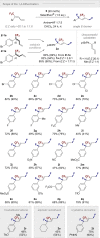Catalytic, Regioselective 1,4-Fluorodifunctionalization of Dienes
- PMID: 36345795
- PMCID: PMC10107283
- DOI: 10.1002/anie.202214906
Catalytic, Regioselective 1,4-Fluorodifunctionalization of Dienes
Abstract
A catalysis-based regioselective 1,4-fluorofunctionalization of trifluoromethyl substituted 1,3-dienes has been developed to access compact, highly functionalized products. The process allows E,Z-mixed dienes to be processed to a single E-alkene isomer, and leverages an inexpensive and operationally convenient I(I)/I(III) catalysis platform. The first example of catalytic 1,4-difluorination is disclosed and subsequently evolved to enable 1,4-hetero-difunctionalization, which allows δ-fluoro-alcohol and amine derivatives to be forged in a single operation. The protocol is compatible with a variety of nucleophiles including fluoride, nitriles, carboxylic acids, alcohols and even water thereby allowing highly functionalized products, with a stereocenter bearing both C(sp3 )-F and C(sp3 )-CF3 groups, to be generated rapidly. Scalability (up to 3 mmol), and facile post-reaction modifications are demonstrated to underscore the utility of the method in expanding organofluorine chemical space.
Keywords: Conformation; Difunctionalization; Fluorination; Hypervalent Iodine; Regioselectivity.
© 2022 The Authors. Angewandte Chemie International Edition published by Wiley-VCH GmbH.
Conflict of interest statement
The authors declare no conflict of interest.
Figures







References
Publication types
MeSH terms
Substances
LinkOut - more resources
Full Text Sources

